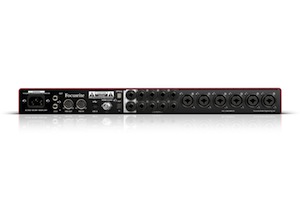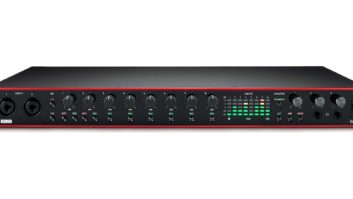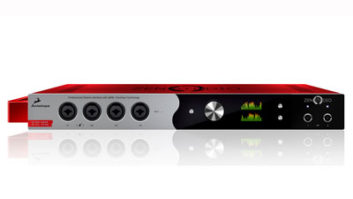
The Focusrite Scarlett 18i20 is a 1U, multichannel USB 2 audio interface with 18 audio inputs and up to 20 outputs, and it could be thought of as the USB version of the Focusrite Saffire Pro 40 FireWire/Thunderbolt interface. It has the same eight Focusrite preamps and front panel controls and is the only model in the Scarlett line to offer a BNC word clock output. The unit is also iOS-capable using the Camera Connection Kit—not included.
In and Out
The 18i20 has MIDI in/out jacks for distributing MIDI data, 24-bit/96kHz AD/DA converter chipsets, and works with any DAW by way of the included Scarlett MixControl software version 1.3—a virtual 18×20 DSP mixer/router that runs in modern PCs and Macs.
There are eight Neutrik XLR Combo input jacks that will handle balanced microphones plus TRS balanced and TS unbalanced line-level ¼-inch inputs. All eight inputs use Focusrite preamps with up to 60 dB of gain. Eight ADAT Lightpipe digital inputs and a stereo S/PDIF bring the count to 18.
The first two inputs are on the front panel with switches for: -10dB attenuator in/out and high impedance Instrument (DI) changeover buttons. Phantom power is switched in two groups of four inputs, 1-4 and 5-8. A set of eight green and red LED trees indicates input signal presence and/or clip at any of the eight analog mic/line inputs.
The back panel’s 20 outputs start with two balanced TRS/TS analog main L/R monitor line outputs, eight more balanced analog TRS/TS outputs, an S/PDIF stereo out and ADAT Lightpipe for eight more digital outs. At sample rates 88.1/96kHz, ADAT ins/outs are halved at four each.
Like the Saffire Pro 40, the 18i20’s front panel has monitor Dim and Mute buttons and individual volume controls for the stereo main monitors and two separate headphone jacks.
The front panel also has green LEDs to indicate power, USB connectivity and word clock sync lock either internally or from an external digital input source. Source and configuration of these features are programmable within MixControl.
MixControl DSP Mixer/Router
MixControl routes and mixes up to 18 input sources with a latency specified at lower than 1.4 ms. The Mixer section has nine stereo faders and a stereo master fader, and they each will unlink (split) into two mono faders—up to 18 mono faders or in any combination of stereo and mono.
All faders have a pan pot, mute, link/unlink, solo and PFL buttons. Input sources from the eight analog inputs, 10 digital inputs and up to 20 outputs from your DAW are selectable via pull-down menus. Any input or output already in use is grayed out in the dropdown, precluding any routing conflicts.
Master faders are assignable up to eight mono mixes or any combination of stereo and mono mixes (a stereo mix uses two). You can rename, save and copy mixes from one mixer to another for quickly creating amended versions of your main monitor mix for alternate mixes and/or “more me” headphone mixes.
The Routing section works globally across all saved mixer configurations. It is for connecting analog inputs, DAW audio sources and mixer outputs directly to any of the 20 physical outputs of Scarlett—be they analog, ADAT or S/PDIF. The Device Status Section indicates: sample rate, sync source/status—internal or external clock coming in on the S/PDIF or ADAT Lightpipe, and USB connectivity. For Windows users, there is a pull-down menu for selecting the ASIO buffer size here.
The Monitor Control section has an onscreen volume control, mute, dim, and L or R mute buttons. You can control the level of both the monitor speakers and the headphones together or independently—virtually or from the front panel controls. You can also elect not to control monitor level and put out full level to an external monitor controller.
Enabled by its numerous outputs, 18i20’s MixControl has eight Monitor Presets—preconfigured monitor routing outputs for: mono, stereo, quad, 2.1, 5.1 and 7.1 surround, and multiple sets of monitor and headphone monitoring. Any output can be muted when needed.
Scarlett à la Mode
There are three basic routing modes for Scarlett’s operation. All modes are customizable to your own specific needs and can be named, stored and recalled.
For initial recording, the DAW Tracking mode routes your DAW’s stereo output to the main monitor outputs. All inputs are monitored from within the chosen DAW Application.
The Zero Latency mode routes mixes developed in MixControl’s stereo mixer directly to the monitor and headphone outs. You can route a stereo “in the box” mix or multiple stem mixes from your DAW for overdubbing and do numerous monitor mixes within MixControl. In either case, while in Record, monitor the tracks in Record directly in MixControl to avoid the latency of your DAW app.
Mixing mode routes DAW Tracks to line outputs of MixControl—all 20 DAW tracks are simultaneously available as physical outputs—good for in-the-box mixing using an external analog summing unit or multiple analog outputs for mixing on a console.
Install, Config, Record, Mix
I used Pro Tools HD 10.3.5 running in a Westmere 8-core Mac Pro, OS 10.8.3. I installed MixControl version 1.3, which requires OS 10.7 or above. Although not supported, I found it worked fine running in OS 10.6.8.
After connecting the L/R Monitor outputs directly to my powered monitors, in Mixing Mode whatever in the box mix I have coming out of Pro Tools I/O A 1-2 goes directly to my monitors. Great for quick setups, Monitor speaker volume is controlled by the 18i20’s front panel control, which cranks up/down the GUI’s large Monitor knob when the HW Control button is switched on.
As an engineer used to recording and mixing in Pro Tools HD 3 Accel systems, I found it easy to use MixControl once I got into the routine of muting tracks I’m recording in PT’s mixer and monitoring them directly along with the rest of the already recorded tracks within MixControl’s mixer to maintain zero latency.
Another workflow change was getting into the habit of storing MixControl setups by song name and mode (mix, tracking, overdubbing, etc.) within the song’s Pro Tools session folder. This “snapshot automation” method also stores the particular monitor/headphone requirements of the musicians, singers and producer during tracking and each subsequent overdub.
I also started to use my HUI controller much more to control PT for punching in and for transport control—this leaves my mouse for full-time control of MixControl.
Let’s Get to It!
I recorded a singer with a new Cathedral Pipes Seville Active ribbon mic. The Focusrite preamp was a good match for this mic, with plenty of gain and smooth sound. I recorded at 96kHz/24 bit, and for overdubbing I recalled my last mixer setup that uses the Zero Latency mode. I used the 18i20’s first input channel on the front—it automatically shows up as A1 in Pro Tools’ interface list and “Anlg 1” in MC. I set the output of the new PT track to A13 and put it in record-ready.
We punched in a lot, and I could easily balance the volume of an already recorded vocal track to the live vocal by selecting channel 13 fader in MC’s mixer, making its input “Anlg In 1” (Analog 1) and renaming it “Mic Input Mon.” Next to that I renamed a channel “Lead Voc” and set its input to DAW 13 for playback of the vocal in PT. This worked great for my singer who likes to hear herself live as well as what’s already recorded at the same time—just make sure you mute the PT track when you go into Record.
Solid Scarlett
With my computer’s FireWire 800 bus free to record and play audio from external drives, I found the Scarlett 18i20 an excellent multichannel interface that offers tremendous value and good sound. I especially like the sound of the mic preamps and the near-infinite creative possibilities and the glitch-free operation of the MixControl software—which is rock solid and the best version yet I’ve experienced. The well-written manual has plenty of configuration setups and ideas, including monitoring routing for up to 7.1-channel surround.
Scarlett comes with Ableton Live Lite DAW; Scarlett VST/AU/RTAS (no AAX yet) plug-in bundle with an EQ, compressor, reverb and gate; and Novation’s Bass Station soft synth, including more than 1 GB of royalty-free samples from Loopmasters.
Barry Rudolph is an L.A.-based recording engineer.
PRODUCT SUMMARY
Company: Focusrite Novation Inc.
Product: Focusrite 18i20 USB Interface
Web:focusrite.com
Price: $499
Pros: Easy setup, intuitive, great sound, MixControl version 1.3.
Cons: Needs a more powerful headphone amp.
Try This
The 18i20 offers a way to connect your outboard analog processing gear to your host-based DAW during mixing or re-recording. First, I routed stem outputs of the song I was mixing into MC’s mixer in zero-latency mode and built my stereo mix.
I elected to use the outputs of MC’s Mix 3 and Mix 4 mixes as mono sends to my 1176LN and dbx 165 limiter/compressors, respectively, by using the monitor routing section: Mix 3 to Line Output 5 and Mix 4 to Line Output 6—rear panel line level outputs of the 18i20.
The outputs of those units would go back into the 18i20 as “Anlg In”—analog source inputs in the main mix. Because both the stems and the processed audio arrive together, latency is not a worry.






